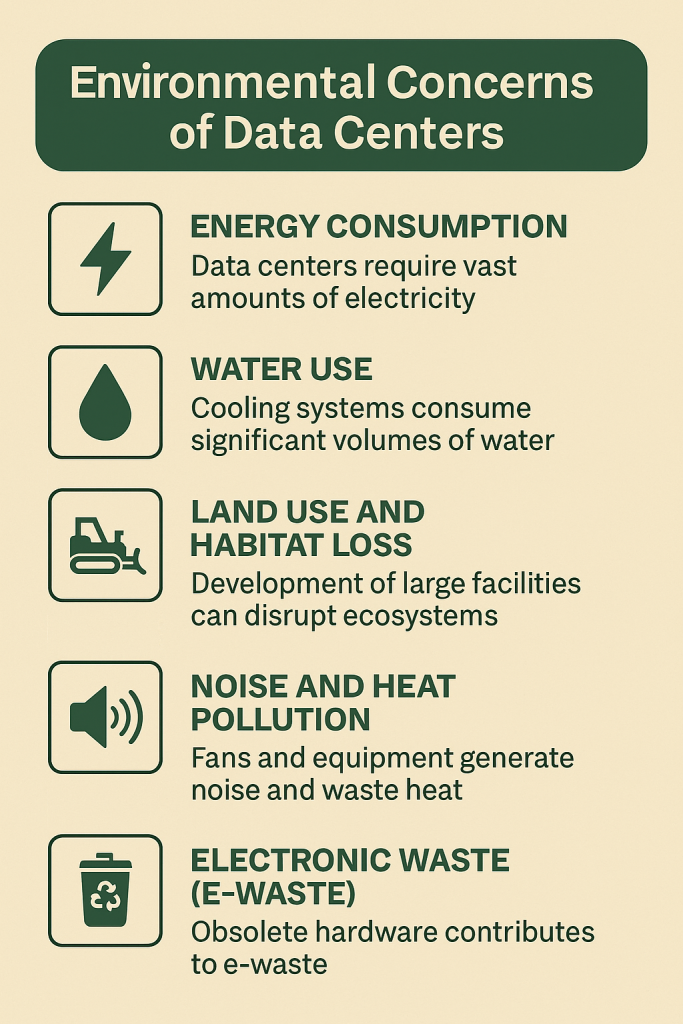The proliferation of data centers is increasing human demands for water, electricity and developed land. Growing per capita environmental demands show the need to limit the number of capitas by ending immigration-driven population growth.
Data centers have become the physical core of the digital age. Every online search, cloud backup and AI query depends on these massive facilities that store and process data nonstop. The U.S. alone now hosts more than 5,000 data centers, driven by surging cloud computing, streaming, e-commerce and artificial intelligence. More than 10% are “hyperscale” facilities with footprints ranging up to hundreds of acres.
Amazon, Google and Microsoft are building campuses that consume as much electricity as small cities. Local governments often welcome them for tax revenue, but they come with growing environmental impacts. These facilities are not weightless “clouds” — their environmental footprint includes energy use, heat and noise pollution, water consumption, land conversion and electronic waste.

Data centers run on vast amounts of electricity, generated primarily by fossil fuels. Each campus operates continuously, with redundant power and cooling systems that magnify overall energy demand. Even where powered by renewable energy, construction materials and backup diesel generators add to carbon emissions. Cooling these facilities — another major challenge — can require hundreds of thousands of gallons of water each day. The cumulative physical footprint is growing as well, replacing farmland and wildlife habitat with sprawling buildings and paved surfaces, the sounds of the countryside with constant mechanical noise.
As America’s immigration-driven population surpasses 340 million, every additional household, school and business adds to the volume of data created, stored and transmitted. The result is a rising physical demand for facilities that consume energy, water and land at industrial scales.
A growing population amplifies total digital demands. Every additional person adds new data streams, digital devices and cloud-based activity that must be processed, stored and cooled somewhere in the physical world. The cumulative effect of our population is enormous: billions of online interactions and terabytes of new data generated daily. Each incremental rise in population amplifies the physical footprint of the digital economy — requiring more data centers, more electricity, more land conversion, and more water drawn from rivers and aquifers. All long-term population growth in America is determined by federal immigration policy.
These environmental impacts are especially acute in water-scarce states experiencing rapid growth in both population and data centers — notably Arizona, Nevada, Utah and Texas. In these states the Colorado River, other rivers and local aquifers are already overdrawn. Each new campus adds millions of gallons of annual demand in basins struggling to supply farms and burgeoning cities.
In Tucson, the No Desert Data Center Coalition is fighting to prevent construction of Project Blue. The Coalition argues that this proposed data center will consume massive amounts of scarce water, even as it creates few permanent jobs for area residents. It also predicts large electricity rate increases for current residents, which have already occurred in other areas where data centers have ramped up electricity demands.
Years of government support, the presence of internet infrastructure, cheap electricity and available land has made Northern Virginia the world leader in the operation of data centers. Virginia had 6,247 megawatts of data centers and 2,610 megawatts under construction as of June 2025. That’s nearly triple that of the next largest market — Columbus, Ohio.
The rapid sprawl of data-center campuses in Virginia has consumed thousands of acres of farmland and open space, triggering community pushback over noise and land-use impacts. The enormous electrical loads required to power these facilities have also contributed to rising electricity rates and new transmission-line projects. While Google and Microsoft pocket the profits, residential and small-business consumers are bearing the costs in higher electricity rates.
A recent AP poll shows Americans are worried about the environmental costs of data centers. We can and should try to make data centers more efficient, but such efforts have their limits and current trends suggest the number of data centers will likely increase. That’s all the more reason to support reducing immigration numbers to levels we can sustain. Trends that increase per capita land, water and energy use are bad enough, but population growth makes them even worse by multiplying their harmful environmental impacts.
Reducing immigration can stabilize the U.S. population, temper the pace of data center construction, and ease long-term infrastructure pressure. A stable population will reduce data demand, reduce construction needs, and reduce the pressure to increase water and energy use.
Currently according to the Census Bureau, the U.S. population is on track to soar to a whopping 375 million by the Year 2060, with about 90% of that growth due to immigration. But this gloomy forecast can be improved by Congressional action. NumbersUSA promotes legislation to humanely reduce immigration. Please visit our Action Board to let your Congressional delegation know you want them to act to reduce immigration into the United States.